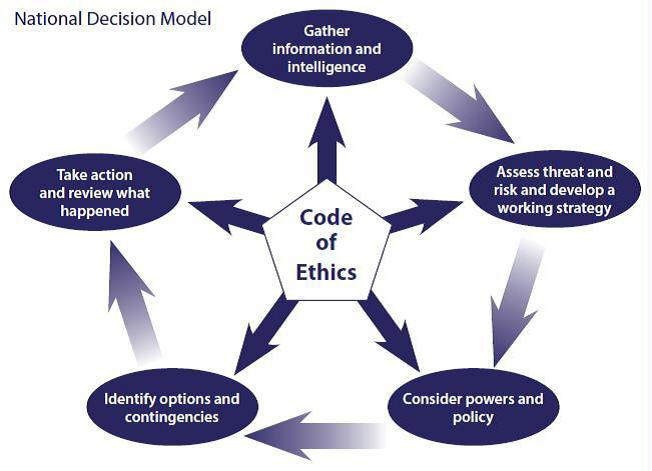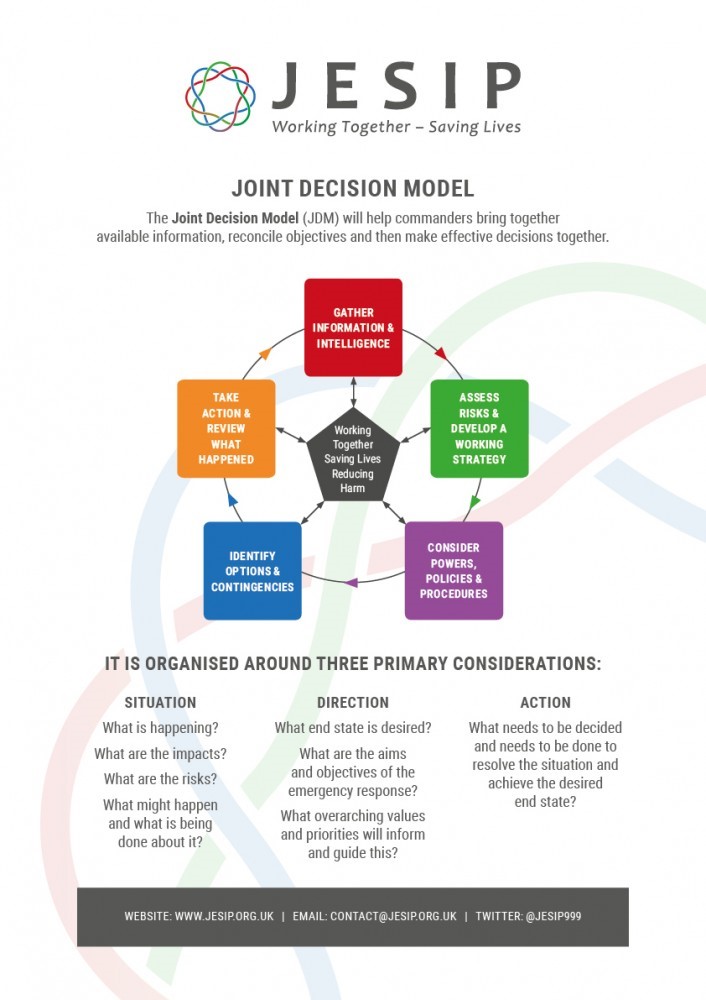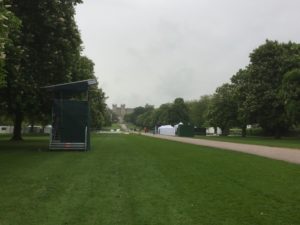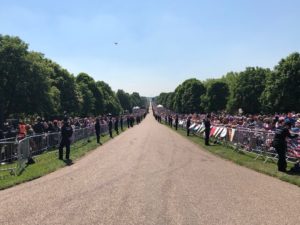
Own Your Own Fear: Problem Solving by Chief Inspector Pete Dalton
This article will feature some of my personal views on problem solving in a specialist command context, it is informed by 26 years of command, advisory and operational experience in Firearms, Counter Terrorism, Public Order, Events and Major Incidents.
The ability to identify, manage, mitigate or solve problems is a key competency for any police or emergency services commander. Applying problem-solving and fast time decision making in a critical incident with a collapsing time frame, often in high-risk scenarios, with the potential for serious harm, is a daunting challenge, especially when new to the role or working towards occupational competence as a commander.
The police in common with other emergency services focusses heavily on the selection, accreditation and continued professional development of commanders and specialist advisors at Strategic, Tactical and Operational levels. Approved Professional Practice (APP) and National Police Training Curriculums are in place to support this process and to enable consistency of decision making and command. More recently, the emergency services have further consolidated these themes through The Joint Emergency Services Interoperability Programme (JESIP). The need to ‘work together to save lives’ has sadly been required on several occasions over the last 12- 18 months, predominantly in response to an increase in low complexity terrorist attacks within the UK and abroad.
Across the specialist operations disciplines of Firearms, Public Order, Counter-Terrorism and Operational management a consistent National Decision Model (NDM) is used. The NDM is taught to all police officers and staff, whatever their rank or role, it enables both fast time decision making and slow time problem-solving. It supports both justification and preclusion of actions. The NDM is subject to its own APP. It forms the fundamental structure in all tactical training. An illustration of the NDM is contained below;

In my role as a specialist firearms commander, I use this model on a daily basis, both in decision making and problem solving. The model builds on cognitive processes and deep seated human decision making processes. The NDM is also used by other emergency services, slightly amended to become a Joint Decision Model (JDM) see below;

I can apply this model in seconds for immediate decisions or over a period of time to problem solve. During 2018, I have had the privilege of planning and commanding the complex specialist tactical firearms plans for both The Royal Wedding of HRH Prince Henry of Wales & Ms Meghan Markle and the working visit of President Trump. These were events of International importance, both presented unique public safety, protective security & counter terrorism challenges.
Planning for both was complex and required liaison with numerous partners, agencies and specialist security personnel. Looking back, I am very proud to have planned and played a role in the wider command structure at these events. However, with regard to ‘owning your own fear’ on being informed that I was to plan and command events at the Tactical level, I must confess to significant nerves, sleepless nights ,a constant focus on the potential threats to both events, the scope & scale of the operations and recognition that both were the largest UK policing operations of recent times. Apprehension, some fear and pre-event nerves are natural for commanders, event managers and any profession where key pressurised decision making is required. The fears for me included, an attack or serious incident at the event, plans or elements of the plan not working, compromise of security or public safety and general impact upon confidence in the police. I find though that ‘owning my fear’ is achieved through confidence in my command ability, confidence in the command team, detailed planning & contingency planning, checking and testing of plans and review through exercises or table-tops.
The detailed specialist firearms plans were developed in conjunction with the event Police Silver (Tactical level commander) and other partners, particularly the Counter Terrorism Security Coordinator and Event Safety Managers. As always, the NDM supplied the consistent framework for planning (used as the agenda at all meetings), briefings and as the structure for written plans.
My professional and operational experience of using the model also compliments wider ‘recognition primed decision making’ abilities. Having been involved in selecting and training commanders for many years, I am very aware that operational competence is enhanced by previous experience, this has been subject to academic research and I am sure applies to any profession or occupation. The use of models and processes are key enablers in allowing structure, providing confidence to yourself and others and in ensuring effective command and planning.
One of many examples where the NDM and problem solving were of assistance was during the planning for The Royal Wedding. Crowd projections and planning assumptions indicated that the largest crowd ever seen within Windsor over 100,000 would attend. These crowds would line the complete 1.7 mile route and be in extremely close proximity (touching distance) in places to the Royal Procession. This crowded space and proximity were later viewed by 1.9 billion viewers around the world, who watched with great pleasure as the Royal Couple’s carriage procession followed the 17 minute route in the May sunshine.
During the build-up International media and ‘security experts’ who are often used by the media, commented on a range of potential terrorism risks present at the event. At times these were presented in what I consider, an alarmist and sensationalist manner, one theme was with regard to ‘snipers’ mounting an attack against the procession from the roof tops of Windsor. With regard to planning and the NDM, the information & intelligence and my subsequent threat assessments indicated that the media commentary being publicised was not consistent with the projected threats or reasonable worse case scenarios. The amount of coverage though did cause many planners and commanders further sleepless nights!
However, my specialist plan had to include the capability and capacity to enable counter-sniper mitigation, this was delivered by highly professional Police Rifle Officers who formed a key functional element of my wider tactical plan. The challenge for me was to work with my rifle team leader to identify sufficient elevated positions to enable complete route coverage.
At first, it appeared that enabling complete coverage along The Long Walk, the high profile 1140 metre tree lined avenue within Windsor Great Park along which the procession passed would be challenging and potentially not feasible. However, through problem solving and partnership with specialist contractors, The Crown Estate and The Royal Borough Local Authority, I was able to provide a tactical option through the construction and deployment of a number of temporary rifle towers along this section of the route.
Initially, the idea of these caused significant concerns over the ‘look and feel’ for the event, some even commenting that the towers would give a ‘Colditz’ look. I was able to brief and present a case though, that reassured the deployment of these towers would mutually support the Public Safety of the 80,000 on this section of the route, support with crime prevention and gathering intelligence. The provision of the rifle over-watch as a protective security measure, would support in countering a sniper threat and also enable a response to a spontaneous attacks. Through planning and problem solving we were able to factor in the construction amongst wider event build-up plans. The structures also proved to be useful to mount CCTV and other event safety infrastructure.
I was very confident that the Public would not be alarmed by the presence of armed officers in these towers or on the ground, over recent years Windsor in common with other iconic locations has seen an increase in armed patrols. In the vast majority of cases these are welcomed, provide reassurance and support engagement. After all, our firearms officers are first and foremost professional police officers who have volunteered and been specially trained to deploy with firearms.
My command and tactical briefings for the deployment of the towers, followed the NDM and was supported by multi-agency meetings. The deployment was subsequently approved and supported the event. They enabled complete coverage along the whole route. It was pleasing to note that with excellent support from the contractors and event management, the structures blended in to the environment, examples before and during the event are shown below , you may note that the line of towers blend into the tree line and crowd;
The wedding, from a policing perspective was a great success, the public engagement and feedback has led to a sense of pride. The day itself passed in a blur for me, it was a pleasure to command over 200 firearms officers from across the UK. The day ended with a briefing from my Assistant Chief Constable, the event Gold (Strategic), commander who informed me, I would be leading the planning and command of the specialist firearms Operation for President Trump six weeks later at a number of venues within our Force Area. Quite a year!
Find out more about Pete Dalton in his Influential Leader interview.
To find out more about developing leaders, take a look at our dynamic and bespoke courses ranging from active learning workshops which require participants to engage with ideas and approaches as individuals, groups and as a cohort. These courses are unique as they are credit rated by Edinburgh Napier University.
Intended outcomes
- To equip high performing managers with the appropriate practical capabilities in the fields of management and leadership.
- To encourage and support participants in developing themselves and their teams as practising managers and leaders.
Or you may wish to try our extreme corporate away days, #BlowYouAwayDays where we offer a range of interactive, highly-pressurised, immersive-learning programmes underpinned by applied leadership and management theory.
Could you negotiate with a kidnapper?
Could you survive a storm?
Could you dance like no one’s watching?
Could you handle a Grand Prix circuit?
Mind Over Matter (MOM) offers extensive training and education in the field of negotiation.
Taken: Out of your Comfort Zone
Here is what people say about us:
“I loved the amount of participation which we had. The scenarios area offers a brilliant way to gain new knowledge and then test it in a safe, but exciting atmosphere”
“The experience that Chris has in many areas means he is so informed. The interactive elements of the course were excellent and I loved the ‘learning in the round’ teaching approach”
Contact us for more information


